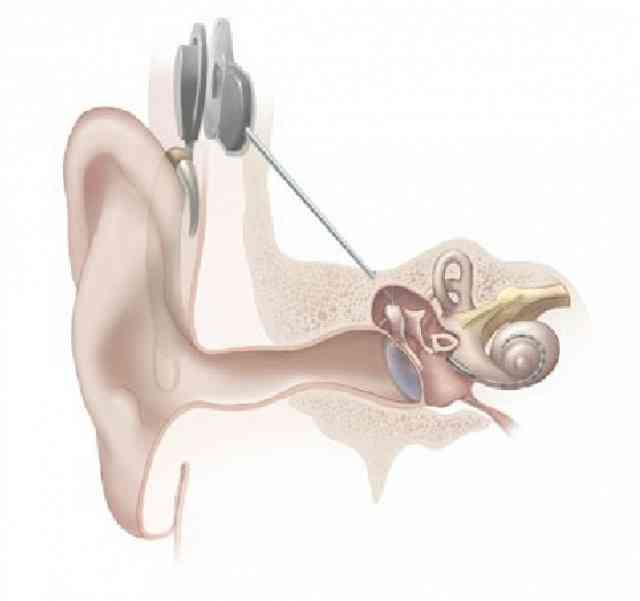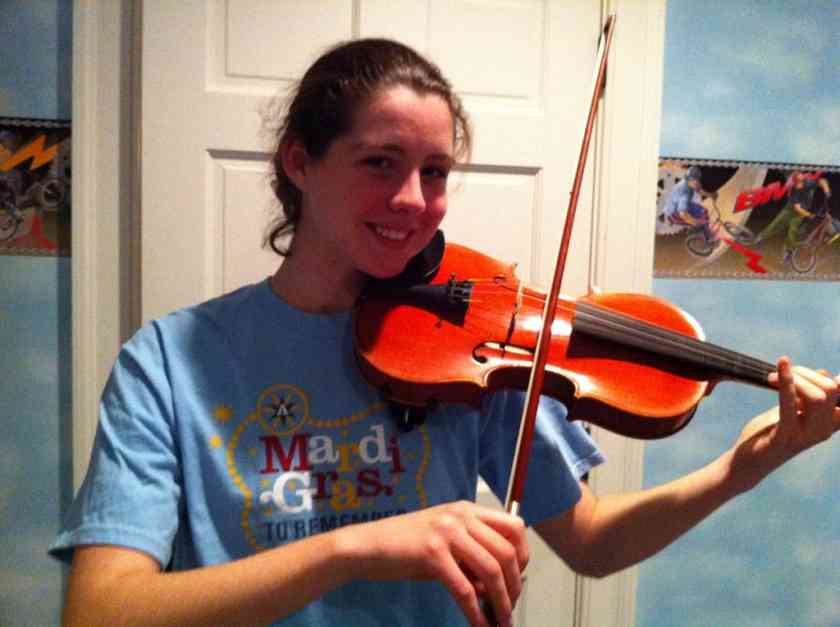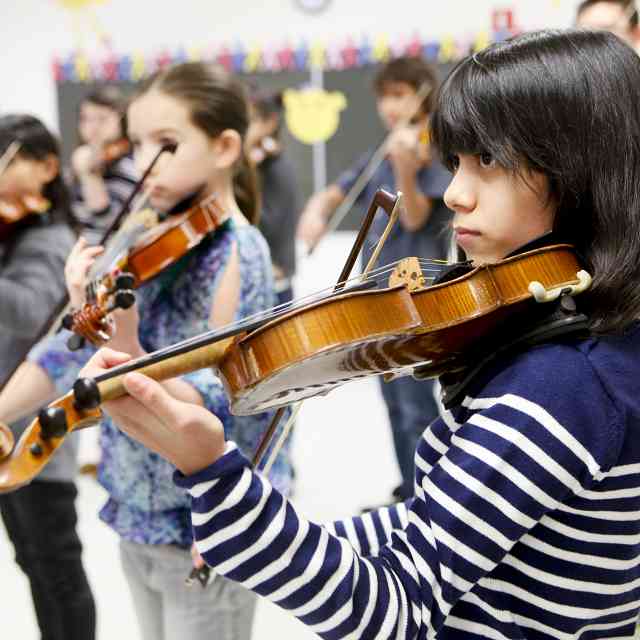Emily’s History
When Emily was born, universal newborn hearing screens were not performed at birth in the hospital as they are today.
Her parents assumed that she was just a good sleeper, able to tune out the loud sounds of her toddler brother. But at four months, they noticed that Emily wasn’t cooing, babbling or responding like other babies. They had her hearing checked, and the diagnosis was profound deafness. Emily’s cochlea was non-functional, preventing any sound from being transmitted from her ears to her brain.

Emily first hears a sound at age 19 months
Emily’s parents researched possible solutions and a cochlear implant appeared to be the best alternative. The standard protocol at the time required wearing hearing aids for one year prior to the implant, which were of no help to her. Emily received her implant at nineteen months, and was the youngest person at that time (1997) in North America to receive an implant. This protocol has changed considerably since then; currently, children in the United States are able to have this operation at age one, and Australia allows a cochlear implant at birth.

Cochlear implant diagram, from the National Institutes of Health
What is a Cochlear Implant?
The cochlear implant is a surgically implanted array of electrodes that converts sound waves into electronic impulses. These impulses are then sent to the brain along the auditory nerve. Speech sounds are initially sensed by a microphone worn behind the ear, and converted by a speech processing program into electronic impulses. The impulses are then transferred via a magnet placed under the scalp to the electrode array in the cochlea.
The sound quality sensed via the implant is considerably different to that experienced by a “hearing” ear. People who have lost their hearing and use implants describe the sounds as being stilted and electronic, much like a computer-generated voice. Evaluation of how people with cochlear implants process musical sound has been limited to, “Which of these two notes is higher?” or “Is this an example of country or classical music?” When Emily wanted to play the violin, with its need for constant pitch and tone regulation, it was a journey into unfamiliar territory for Emily’s family, her violin teacher, and the implant specialists.
Emily’s Adventure in Hearing
Emily’s parents kept an extremely quiet home until Emily was four years old so that she could learn to hear voices clearly, a skill necessary to develop her own speaking ability. Music was played often (usually classical), but the TV was rarely on. Emily’s family chose not to teach her sign language, training Emily to perceive speech by honing her listening skills rather than reading lips.
When Emily started Suzuki violin lessons at age five, she did not have a natural sense of pulse, timing, or musical cadence. Because she had never heard and absorbed the typical array of nursery rhymes and songs, Emily had to be taught how to feel a beat and how to sing a melody. We used marching, dancing, rocking, bouncing, jumping, clapping, tapping, chanting, acting, and drumming to fill in the gaps in Emily’s musical education.

Emily playing violin
The Challenge of Playing the Violin
Tone:
Emily grasped the technique of sound production (controlling bow arm weight, bow speed, and distance from the bridge) more easily than the concept of listening for a clean and clear tone. Emily’s mother also studied the violin, providing another learning opportunity: Emily could watch and hear her mother work on producing her own beautiful tone. The Suzuki violin recording was played daily, which was fundamental to her concept of tone development.
Intonation:
At first, Emily’s ability to play in tune was entirely visual. While waiting for her sense of pitch to develop, we used fingerboard tapes and delayed note reading so that she could observe her finger accuracy.
Emily is now able to distinguish by ear when her fingers are even slightly out of tune, and adjust accordingly.
Playing in an Ensemble:
The cochlear implant does not filter or prioritize sound, so all sounds impinge on Emily’s brain with equal force. Because of this, playing in an orchestra can be overwhelming. Emily plays well in small groups by carefully observing the leader’s fingerings and bowings. She delights in playing harmony parts to Suzuki pieces. Emily understands and implements dynamics, phrasing, articulation, and musicality, and recently composed and performed her original piece: a violin, flute and piano trio.
Repertoire and Technique:
Emily is polishing Dvorak’s Humoresque (Suzuki Book Three) and Clebanov’s Millionaire’s Hoedown. She shifts through fourth position, and has a good basic understanding of vibrato.
Picking out her own instrument:
When it was time for Emily to move up to a full-size violin, several instruments were shipped to her home on approval. Remarkably, she identified the best sounding instrument on her own. Emily described hearing variations in timbre, probably aided by feeling the resonance and vibrations in the instrument’s wood. Similarly, she chose the bow with the best tone and physical response. After I selected the best of the instruments and bows at Emily’s lesson, I was stunned to discover that she had chosen the very same ones by herself at home. What made this so extraordinary is that more advanced and adult students cannot hear these subtle differences between instruments!
Future:
Emily has surpassed everyone’s expectations of what is possible with a cochlear implant. She speaks in a normal voice, plays the violin, and enjoys listening daily to a variety of different types of music.
Given that Emily is five feet seven and still growing, the viola may be a good option for her. An added benefit of switching to the viola would be the resonance of the low C string, as the violin E string painfully distorts in upper frequencies.
Emily is gifted physically, intellectually, and socially. Not only is she an excellent student, she is a member of her school’s cross country, track and basketball teams. Emily is a lovely young woman with a gentle spirit and a loving soul, and is completely unaware of her own inner and outer beauty. Her self-deprecating humor is best illustrated by a personal anecdote that she tells about herself: This past fall, her cross-country coach, mindful of the expensive and humidity-sensitive implant, suggested that Emily take off her earpiece while running. With a wry smile, she responded, “No thanks, I’d rather not be alone with my thoughts!”
Hear Emily and her mother speak more about their experience with the cochlear implant and the Suzuki Method in the following video by Irene Mitchell:










Comments
Brienzwiler, Switzerland
26 posts
Thanks for sharing. What an inspiring story, and an inspiring young lady!
Kathleen Spring
What a beautiful story, Irene! I wish Emily all the best! She and her mom are delightfully candid!